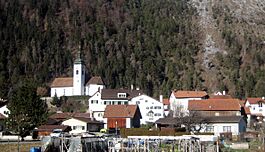Felsberg, Switzerland facts for kids
Quick facts for kids
Felsberg
|
||
|---|---|---|
 |
||
|
||
| Country | Switzerland | |
| Canton | Graubünden | |
| District | Imboden | |
| Area | ||
| • Total | 13.4 km2 (5.2 sq mi) | |
| Elevation | 572 m (1,877 ft) | |
| Population
(Dec 2020 )
|
||
| • Total | 2,640 | |
| • Density | 197.0/km2 (510.3/sq mi) | |
| Postal code |
7012
|
|
| Surrounded by | Chur, Domat/Ems, Haldenstein, Pfäfers (SG), Tamins | |
| Twin towns | Felsberg (Germany) | |
Felsberg (which is called Romansh: Favugn in the Romansh language) is a small town in Switzerland. It is a municipality located in the Imboden Region in the canton of Graubünden.
Contents
History of Felsberg
Felsberg has a long history. It was first written about around the year 840. Back then, it was known as in villa Fagonio. Later, in 1290, its German name veltsperch was used.
Geography of Felsberg
Felsberg covers an area of about 13.4 square kilometers (which is about 5.2 square miles). A big part of this land is covered by forests, making up about 43.6%. About 20.2% of the land is used for farming.
Only a small part, about 4.3%, has buildings or roads. The rest of the land, about 31.9%, is made up of rivers, glaciers, or mountains. Felsberg is in a small valley. It is located north of the Rhine river, between the towns of Chur and Domat/Ems.
People and Population
Felsberg is home to over 3,000 people. In recent years, the number of people living here has grown steadily. About 8.6% of the people in Felsberg are from other countries.
Age Groups in Felsberg
The population of Felsberg includes people of all ages.
- About 12.6% of the people are young children, aged 0 to 9 years old.
- Another 8.7% are between 10 and 14 years old.
- About 7.6% are teenagers, aged 15 to 19.
- Adults aged 20 to 59 make up a large part of the population.
- About 11.8% are aged 50 to 59.
- Older adults, aged 60 and above, make up about 14.5% of the population.
Education and Jobs
Most adults in Felsberg are well-educated. About 81.7% of people aged 25-64 have finished advanced schooling. This includes either upper secondary education (like high school) or higher education (like university).
Felsberg has a low unemployment rate, which means most people who want to work have jobs. People work in different types of jobs:
- Primary sector: This includes jobs like farming. About 36 people work in this area.
- Secondary sector: These are jobs in manufacturing or construction. About 143 people work here.
- Tertiary sector: This includes service jobs, like working in shops or offices. About 147 people work in this sector.
Languages Spoken
Most people in Felsberg speak German. About 91.6% of the population uses German as their main language. The second most common language is Romansh, spoken by about 3.0% of the people. Albanian is the third most common language, spoken by about 1.2%.
| Languages | Census 1980 | Census 1990 | Census 2000 | |||
|---|---|---|---|---|---|---|
| Number | Percent | Number | Percent | Number | Percent | |
| German | 1183 | 86.41% | 1599 | 90.23% | 1859 | 91.62% |
| Romansh | 86 | 6.28% | 71 | 4.01% | 60 | 2.96% |
| Italian | 59 | 4.31% | 22 | 1.24% | 20 | 0.99% |
| Population | 1369 | 100% | 1772 | 100% | 2029 | 100% |
Historical Population Growth
The population of Felsberg has grown over time. Here's how it has changed:
| year | population |
|---|---|
| 1850 | 482 |
| 1900 | 647 |
| 1950 | 939 |
| 1980 | 1,369 |
| 1990 | 1,772 |
| 2000 | 2,029 |
Transportation in Felsberg
You can travel to Felsberg by train. The Rhaetian Railway offers services to the Felsberg train station.
See also
 In Spanish: Felsberg para niños
In Spanish: Felsberg para niños
Images for kids






